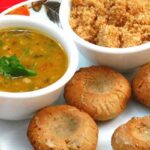Rajasthani Food Guide, the land of kings, palaces, and vibrant culture, is equally renowned for its delectable cuisine. Rajasthani food is a treat for food lovers, with its bold flavors, unique cooking techniques, and a wide array of vegetarian and non-vegetarian dishes. One of the most iconic Rajasthani dishes is Dal Baati Churma. It consists of baati, which are hard wheat rolls traditionally baked in a clay oven or on cow dung cakes. These baatis are served with dal (lentils) and churma, a sweet powdered wheat dish. The combination of the crispy baatis, flavorful dal, and the sweetness of churma creates a harmonious blend of flavors.
For meat lovers, Laal Maas is a must-try. This fiery meat curry is made with mutton or goat cooked in a rich and spicy red chili gravy. The dish is known for its intense flavors and is often enjoyed with bajre ki roti (pearl millet bread) or rice. Gatte ki Sabzi is a popular vegetarian dish made with gram flour dumplings cooked in a yogurt-based curry. The dumplings are simmered in a tangy and spicy gravy, resulting in a delightful and comforting dish.
Ker Sangri is a unique Rajasthani specialty made from dried berries (ker) and beans (sangri) found in the arid regions. It is cooked with spices and creates a savory and tangy dish that pairs well with roti or as a side dish with dal and rice. Rajasthan is also famous for its sweets. Mawa Kachori is a sweet pastry filled with a rich mixture of mawa (milk solids), nuts, and cardamom. It is deep-fried and then dipped in sugar syrup, making it a heavenly treat.
Ghewar, a disc-shaped sweet made with flour, ghee, and sugar syrup, is another popular Rajasthani dessert. It has a porous texture and is often garnished with nuts and saffron Rajasthan Budget Tours.
To experience the diverse flavors of Rajasthan, indulge in a Rajasthani thali (platter) that offers a variety of dishes like dal, baati, churma, gatte ki sabzi, ker sangri, and an assortment of sweets. It provides a wholesome and satisfying experience of Rajasthani cuisine in one meal. Exploring local street food stalls and dining at traditional Rajasthani restaurants will allow you to discover hidden gems and savor the authentic flavors of the region. Rajasthani cuisine is a delightful journey that will leave you craving for more.
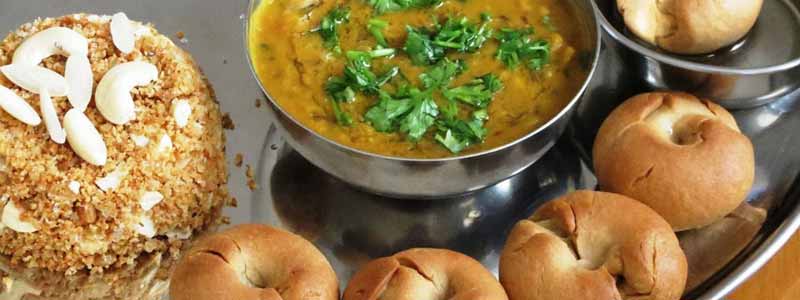
Top 10 foods to try in Rajasthan
Rajasthani cuisine is known for its rich flavors, vibrant colors, and royal heritage. It offers a wide array of vegetarian and non-vegetarian dishes that are influenced by the arid climate and cultural traditions of the region. Here’s a guide to some of the popular Rajasthani dishes you should try:
Dal Baati Churma:
Dal Baati Churma is the quintessential Rajasthani dish that embodies the rich flavors and culinary heritage of the region. It is a complete meal consisting of three components: dal, baati, and churma.
Dal refers to lentils cooked to perfection. In the case of Dal Baati Churma, it is typically prepared using a combination of lentils such as moong dal (split green gram) or toor dal (pigeon pea). The lentils are cooked with aromatic spices, including cumin, coriander, turmeric, and red chili powder, to create a flavorful and hearty dal.
Baati is the star of the dish, which are hard wheat rolls. Traditionally, they were baked in clay ovens or over cow dung cakes, imparting a distinct smoky flavor. However, they are now commonly baked in modern ovens as well. Baatis are made by kneading whole wheat flour, ghee (clarified butter), and a pinch of salt into a stiff dough. The dough is then shaped into small round balls and baked until golden brown and crispy on the outside while remaining soft and flaky on the inside. The baatis are often brushed with ghee before serving, adding an extra layer of richness.
Churma is a sweet crumbled wheat mixture that completes the Dal Baati Churma experience. It is made by grinding coarsely crushed baatis with ghee and sugar or jaggery. The addition of nuts, such as almonds or cashews, and aromatic spices like cardamom further enhance the flavors. Churma offers a delightful contrast to the savory dal and baati, adding a touch of sweetness to the meal Rajasthan Group Tour Packages.
To enjoy Dal Baati Churma, the baatis are traditionally broken into pieces and served with a generous ladle of dal and a sprinkling of churma on top. The combination of the three elements creates a harmonious blend of flavors and textures. The crispy baatis, creamy dal, and sweet churma come together to create a truly satisfying and wholesome meal.
Dal Baati Churma is not just a dish; it is a cultural symbol representing the rich culinary traditions and royal heritage of Rajasthan. It is a must-try for anyone visiting the region to truly appreciate the flavors and authenticity of Rajasthani cuisine.
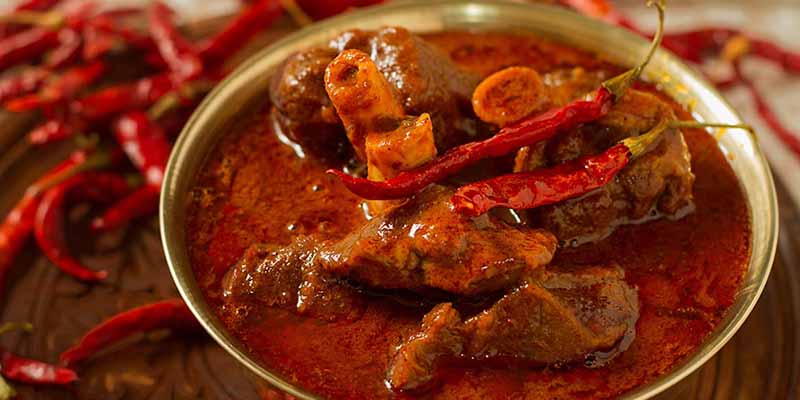
Laal Maas:
Laal Maas is a renowned Rajasthani dish that stands out for its fiery and robust flavors. Literally meaning “red meat” in Hindi, Laal Maas is a popular non-vegetarian delicacy that showcases the bold and intense side of Rajasthani cuisine.
The dish is traditionally prepared using mutton or goat meat, which is cooked in a luscious and spicy red chili gravy. The vibrant red color of the curry comes from the abundant use of dried red chilies, which are a key ingredient in the preparation. The chilies are soaked, ground into a paste, and then added to the rich base of ghee (clarified butter), garlic, onions, and a blend of aromatic spices like cloves, cinnamon, and cardamom. This combination infuses the meat with a tantalizing flavor profile.
Laal Maas is known for its robust and fiery taste, making it a favorite among spice enthusiasts. The blend of spices and the slow cooking process ensure that the meat becomes tender and absorbs the flavors of the aromatic gravy. The dish strikes a balance between the heat of the chilies and the rich, complex flavors of the spices, creating a truly indulgent experience.
Traditionally, Laal Maas is enjoyed with bajre ki roti (pearl millet bread) or plain rice. The rustic flavors of the bread or rice complement the boldness of the curry. It is often garnished with fresh coriander leaves and served with a side of cooling raita (yogurt sauce) to provide a refreshing contrast to the spice.
Laal Maas is not only a delicious dish but also holds cultural significance. It originated in the royal kitchens of Rajasthan, where it was served to the Rajput warriors as a symbol of valor and strength. Today, it continues to be a prominent part of Rajasthani cuisine, celebrated for its bold flavors and gastronomic appeal.
For those seeking an unforgettable culinary adventure in Rajasthan, trying Laal Maas is a must. Its fiery nature and rich flavors make it an iconic dish that represents the essence of Rajasthani cuisine.
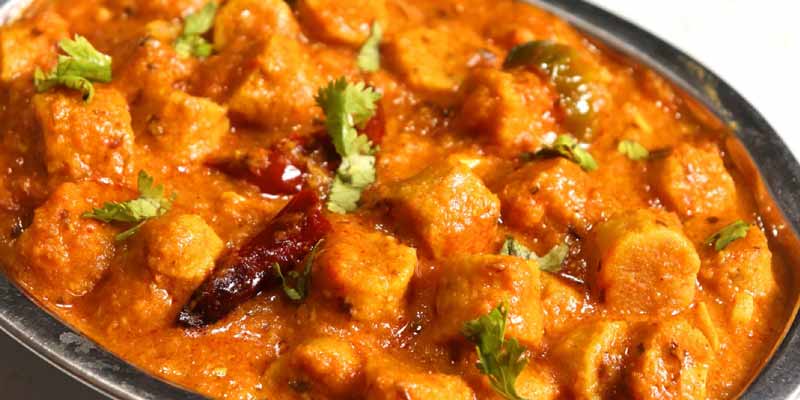
Gatte ki Sabzi:
Gatte ki Sabzi is a popular and flavorful vegetarian dish from Rajasthan, India. It is a curry made with gram flour dumplings simmered in a tangy yogurt-based gravy. Gatte, the dumplings, are the highlight of this dish.
To prepare the gatte, a dough is made using gram flour (besan), spices, and a touch of oil or ghee. The dough is kneaded well and shaped into cylindrical rolls. These rolls are then boiled until they become firm and cooked through. The cooked rolls are sliced into bite-sized pieces, which are then added to the curry.
The curry for Gatte ki Sabzi is prepared by mixing yogurt with a blend of spices like turmeric, red chili powder, coriander, and cumin. This spiced yogurt mixture is then cooked on low heat, stirring continuously to prevent curdling. Once the yogurt mixture thickens, the boiled gatte pieces are added to it. The curry is simmered until the flavors meld together, and the gatte absorb the tangy and aromatic gravy.
Gatte ki Sabzi is known for its unique combination of flavors. The tanginess of the yogurt-based gravy is balanced by the spices, creating a delicious and creamy curry. The gatte themselves add a delightful texture to the dish, with a slightly chewy exterior and a soft interior. The dish is often garnished with fresh coriander leaves and served with roti (Indian bread) or steamed rice.
Gatte ki Sabzi is a popular choice in Rajasthani households and is also served in traditional thalis (platters) or Rajasthani restaurants. It showcases the ingenious use of gram flour, which is a staple in Rajasthani cuisine. The dish is not only delicious but also provides a good source of protein and essential nutrients.
Whether you are a vegetarian or simply looking to explore the diverse flavors of Rajasthani cuisine, Gatte ki Sabzi is a must-try dish. Its tangy and creamy curry, paired with the delectable gatte, is sure to satisfy your taste buds and leave you craving for more of Rajasthan’s culinary delights.
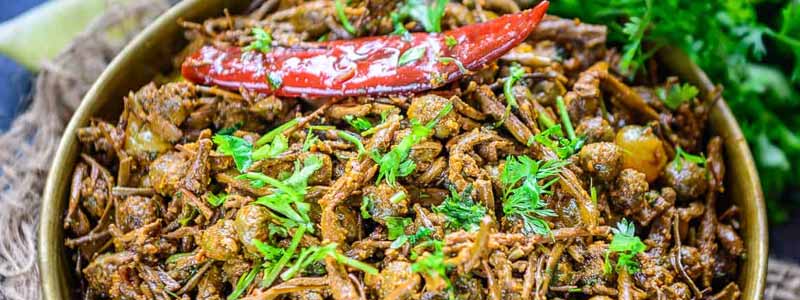
Ker Sangri:
Ker Sangri is a unique and flavorsome Rajasthani dish that represents the culinary heritage of the region. It is a traditional and popular dish that combines two key ingredients found abundantly in the arid regions of Rajasthan: ker berries (also known as wild berries) and sangri beans (also known as khejri beans).
Ker berries are small, round berries that grow on desert shrubs. Sangri beans are long beans derived from the khejri tree. Both these ingredients are dried and preserved for culinary use, as they are abundantly available in the arid landscapes of Rajasthan.
To prepare Ker Sangri, the dried ker berries and sangri beans are soaked overnight to soften them. They are then cooked together with a combination of spices and flavors. Common spices used include red chili powder, turmeric, coriander powder, and cumin. Additionally, ingredients like dried mango powder (amchur), fenugreek seeds, and asafoetida (hing) are added to enhance the taste.
The dish is cooked slowly until the ker berries and sangri beans become tender and absorb the flavors of the spices. The result is a savory and tangy dish with a slightly chewy texture. Ker Sangri can be enjoyed as a main course with roti or steamed rice or as a side dish along with dal (lentils) and other Rajasthani delicacies.
The unique combination of flavors and the use of indigenous ingredients make Ker Sangri a standout dish in Rajasthani cuisine. It represents the resourcefulness of the people in adapting to the arid environment and transforming simple ingredients into a flavorful and satisfying dish.
When visiting Rajasthan or exploring Rajasthani cuisine, don’t miss the opportunity to savor Ker Sangri. Its distinct taste and cultural significance will take you on a culinary journey through the vibrant flavors of the region.
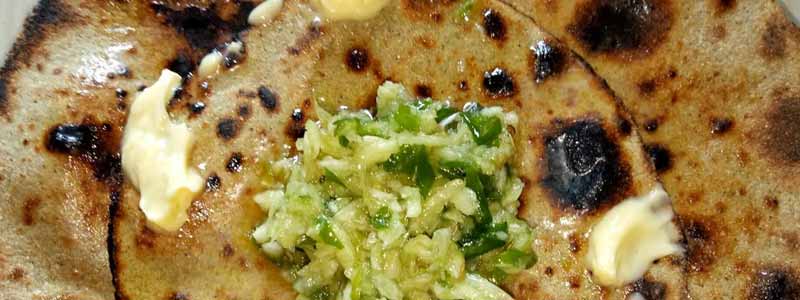
Bajre ki Roti with Lashun ki Chutney:
Bajre ki Roti with Lashun ki Chutney is a classic and popular combination in Rajasthani cuisine. Bajre ki Roti refers to flatbread made from pearl millet flour, while Lashun ki Chutney is a flavorful garlic chutney. This combination offers a delightful blend of textures and flavors.
Bajre ki Roti is a staple in Rajasthan, particularly in rural areas where pearl millet is commonly grown. The roti is prepared by mixing bajra flour with water and kneading it into a dough. It is then rolled out into circular flatbreads and cooked on a hot griddle or tawa. The rotis are slightly thicker and denser compared to wheat flour rotis, giving them a distinct taste and texture.
Lashun ki Chutney, or garlic chutney, is a spicy condiment that perfectly complements the bajre ki roti. It is made by grinding fresh garlic cloves, red chili powder, cumin seeds, salt, and a squeeze of lemon juice into a smooth paste. The chutney packs a punch with its strong and tangy flavors, and the garlic adds a distinctive aroma.
When served together, the nutty and earthy flavors of the bajre ki roti harmonize with the fiery and garlicky notes of the chutney. The roti provides a wholesome base, while the chutney adds a burst of flavor and spice. The combination is not only delicious but also nutritious, as bajra is a rich source of dietary fiber and essential minerals.
Bajre ki Roti with Lashun ki Chutney is a popular choice for meals in Rajasthan, especially during winter months when bajra is in abundance. It is often enjoyed with other Rajasthani dishes such as dal, gatte ki sabzi, or ker sangri to create a complete and satisfying meal.
If you want to experience the authentic flavors of Rajasthani cuisine, don’t miss the opportunity to savor Bajre ki Roti with Lashun ki Chutney. It is a delightful combination that showcases the unique ingredients and culinary traditions of the region.
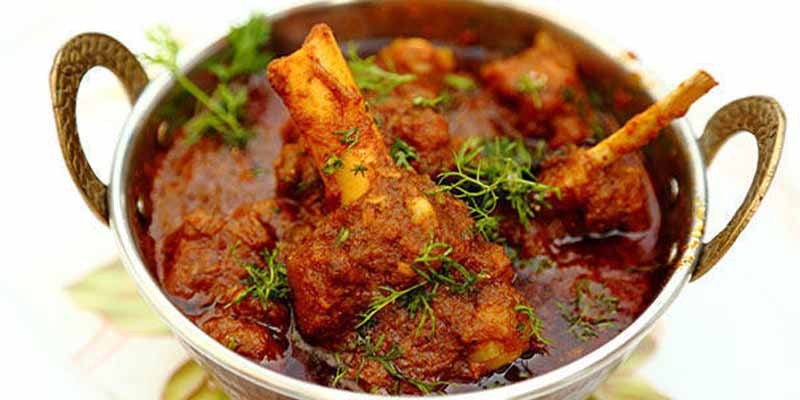
Mohan Maas:
Mohan Maas is a luxurious and indulgent Rajasthani dish that is fit for royalty. It is a rich and creamy meat curry that is known for its unique combination of flavors and aromatic spices.
Traditionally, Mohan Maas is made with tender cuts of mutton or lamb that are marinated in a mixture of yogurt, spices, and a special ingredient called khus-khus (poppy seeds). The marinated meat is then cooked slowly in ghee (clarified butter) along with a blend of fragrant spices such as cinnamon, cardamom, cloves, and bay leaves.
What sets Mohan Maas apart is the addition of saffron, milk, and a touch of sweetness. Saffron lends a vibrant yellow color and a subtle floral flavor to the curry. The milk is added to create a creamy and luscious texture, while the sweetness comes from sugar or honey, balancing the flavors of the spices.
The slow cooking process allows the meat to become tender and absorb the flavors of the spices and the creamy sauce. The result is a dish that is rich, aromatic, and indulgent.
Mohan Maas is often served on special occasions and during royal feasts in Rajasthan. It is typically enjoyed with Indian bread, such as naan or roti, or with fragrant basmati rice. The combination of the tender meat and the flavorful sauce makes it a memorable and decadent culinary experience.
If you have the opportunity to try Mohan Maas, prepare yourself for a royal treat. Its rich flavors and luxurious ingredients make it a standout dish in Rajasthani cuisine, showcasing the regal heritage and culinary excellence of the region.
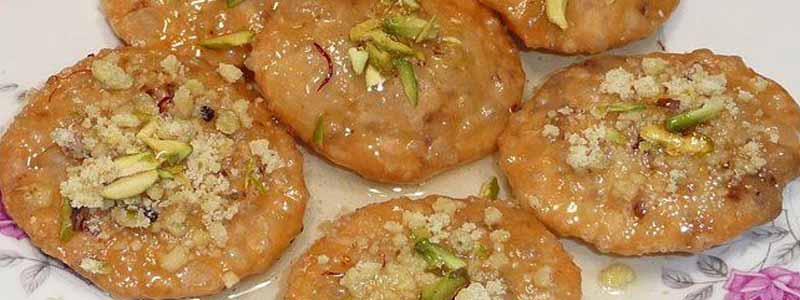
Mawa Kachori:
Mawa Kachori is a delightful and indulgent sweet pastry that hails from the royal cuisine of Rajasthan. It is a popular dessert that is known for its rich and delectable filling.
The pastry shell of Mawa Kachori is made from refined flour (maida), ghee (clarified butter), and a pinch of salt. The dough is kneaded until it becomes smooth and then rolled out into small circles. The circles are filled with a generous amount of mawa, which is a sweet mixture of milk solids, sugar, and aromatic spices like cardamom and saffron. The edges of the pastry are then sealed and shaped into a round or flattened shape.
The filled pastries are deep-fried until they turn golden brown and crispy. Once they are fried, they are taken out of the oil and allowed to cool for a while. Mawa Kachori is typically served at room temperature or slightly warm.
What sets Mawa Kachori apart is its delightful garnish. After frying, the pastries are dipped in a sugar syrup that coats the outer layer and imparts sweetness. They are then topped with a drizzle of saffron-infused syrup and garnished with chopped nuts like almonds and pistachios. This combination of textures and flavors creates a truly irresistible treat.
Mawa Kachori is enjoyed as a dessert or as a sweet snack in Rajasthan. It is often served during festivals, weddings, and special occasions. Its rich and sweet taste makes it a favorite among those with a sweet tooth.
When you take a bite of Mawa Kachori, you experience the crispness of the pastry shell followed by the creamy and sweet mawa filling. The syrup and nut garnish add a delightful touch of sweetness and crunch.
If you have a chance to try Mawa Kachori, be prepared to indulge in a decadent and flavorsome dessert. Its combination of textures, flavors, and the richness of the mawa filling will leave you craving for more of this iconic Rajasthani sweet treat.
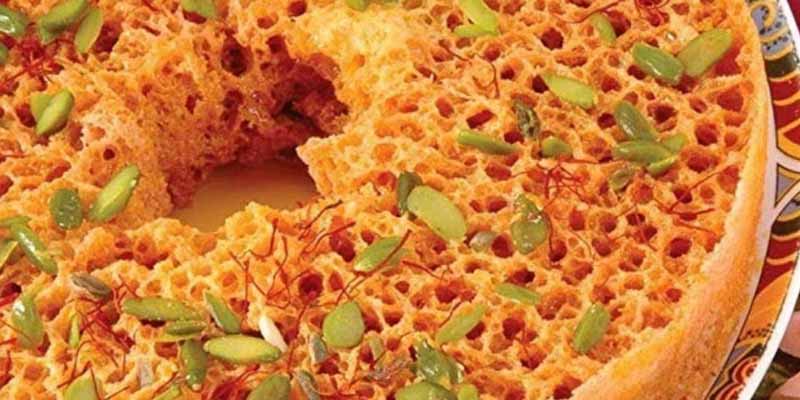
Ghewar:
Ghewar is a famous and traditional Rajasthani dessert that is known for its unique appearance and delightful taste. It is a disc-shaped sweet made from a batter of flour, ghee (clarified butter), and water. Ghewar is typically enjoyed during festivals and special occasions in Rajasthan, especially during the Teej festival.
To prepare Ghewar, a batter is made by mixing flour and ghee with water. The batter is then poured into a wide, shallow pan or a special ghewar mold. The pan or mold has a perforated bottom, which allows the batter to form a lacy and porous structure when deep-fried. The batter is carefully poured into the hot ghee, creating a circular shape with intricate patterns. The ghee is continuously poured over the batter while frying to give it a unique texture.
Once fried to a golden color, the Ghewar is carefully removed from the ghee and drained. It is then soaked in a sugar syrup, which adds sweetness and moistness to the dessert. Ghewar can be served as is, or it can be further adorned with various toppings like chopped nuts, saffron strands, or a drizzle of flavored syrups.
The texture of Ghewar is what makes it truly special. It has a crispy and porous outer layer with a slightly syrup-soaked and soft interior. The combination of textures, along with the sweetness of the sugar syrup, creates a delightful contrast and a burst of flavors in every bite.
Ghewar is available in different varieties, such as plain Ghewar, Mawa Ghewar (made with milk solids), Malai Ghewar (topped with clotted cream), and more. Each variety offers a unique twist and flavor profile.
If you have the opportunity to try Ghewar, be prepared for a sweet and indulgent experience. Its intricate design, crispy texture, and syrupy sweetness make it a beloved dessert in Rajasthan, and it is sure to leave a lasting impression on your taste buds.
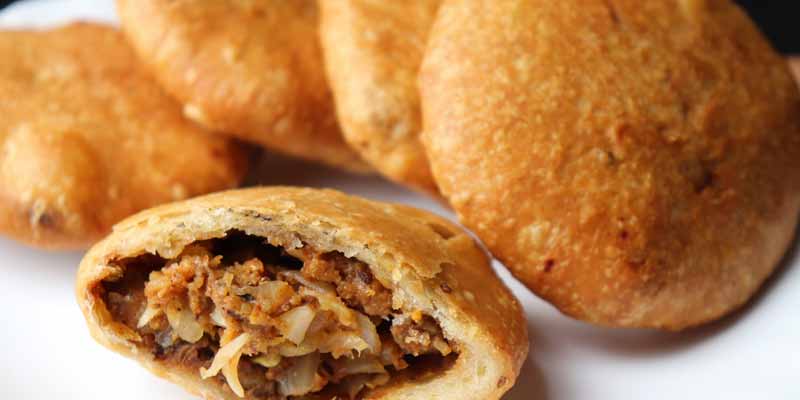
Pyaaz Kachori:
Pyaaz Kachori is a popular savory snack from Rajasthan that is loved for its crispy texture and flavorful onion filling. It is a deep-fried pastry filled with a mixture of spiced onions and other aromatic ingredients.
The outer shell of Pyaaz Kachori is made from a dough prepared with all-purpose flour (maida) and a small amount of ghee or oil. The dough is kneaded until it becomes smooth and pliable. Small rounds of dough are then rolled out and filled with a mixture of finely chopped onions, spices, and sometimes additional ingredients like gram flour (besan), fennel seeds, and a touch of lemon juice. The filling is seasoned with spices such as cumin, coriander, chili powder, and garam masala, which lend a savory and aromatic flavor.
Once the filling is placed in the center of the rolled-out dough, the edges are sealed and the kachori is shaped into a flattened ball or a disc. The filled pastries are then deep-fried until they turn golden brown and acquire a crispy texture.
Pyaaz Kachori is typically served with a tangy tamarind chutney or green chutney, which complements the flavors of the kachori. Some variations may also include aloo (potato) stuffing along with the onion filling, adding an extra layer of flavor and texture.
The combination of the crispy, flaky outer shell and the savory, spiced onion filling creates a burst of flavors in each bite. The sweetness of the onions, combined with the aromatic spices, makes Pyaaz Kachori a delicious and satisfying snack.
Pyaaz Kachori is widely enjoyed as a street food snack in Rajasthan and has gained popularity across India. It is often served as part of a traditional Rajasthani breakfast or enjoyed as an evening snack with a hot cup of tea.
If you have the chance to try Pyaaz Kachori, be prepared for a flavorful and crispy treat. Its savory filling and crispy crust make it a beloved delicacy in Rajasthan, showcasing the rich culinary heritage of the region.
Rajasthani Thali:
The Rajasthani Thali is a sumptuous and diverse culinary experience that brings together a plethora of flavors and dishes from the vibrant state of Rajasthan, India. It is a well-rounded platter consisting of a variety of vegetarian and non-vegetarian delicacies served in small bowls, offering a complete meal in itself.
The thali typically includes an assortment of dishes such as Bajre ki Roti (pearl millet flatbread), Dal Baati (baked wheat balls served with lentils), Gatte ki Sabzi (gram flour dumplings in yogurt gravy), Ker Sangri (dried berries and beans curry), Rajasthani Kadhi (yogurt-based curry), Biryani or Pulao (aromatic rice dishes), and a range of delectable desserts like Malpua and Ghevar.
Accompanying these dishes are flavorful chutneys, pickles, and refreshing beverages like chaas (buttermilk) or lassi (yogurt-based drink). The thali showcases the rich culinary heritage of Rajasthan, with its robust flavors, use of indigenous ingredients, and traditional cooking techniques.
A Rajasthani Thali is not just a meal but a cultural experience, representing the hospitality and opulence of Rajasthani cuisine. It allows you to savor a multitude of flavors, textures, and aromas that are unique to the region, providing a memorable and satisfying gastronomic journey into the heart of Rajasthan.

